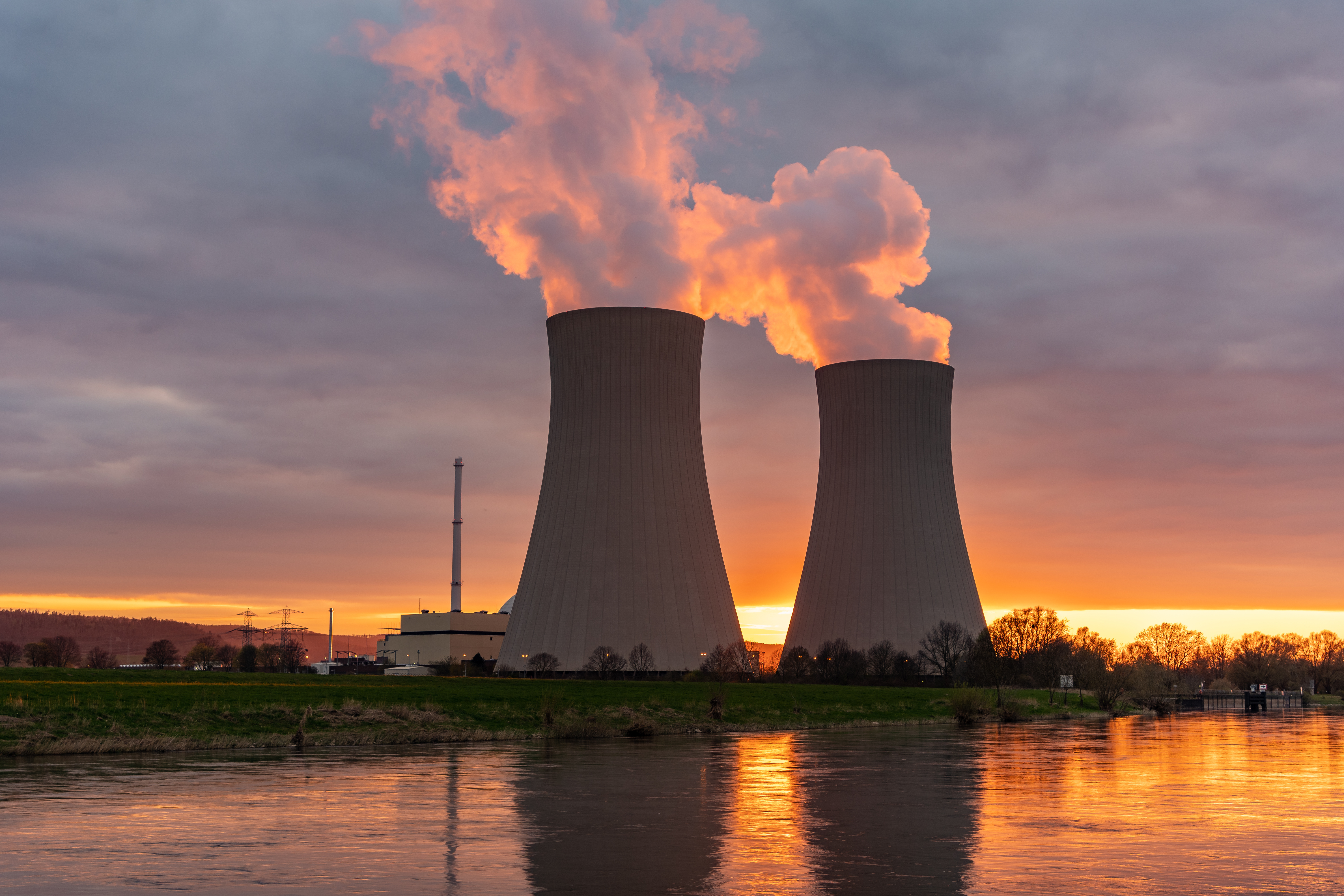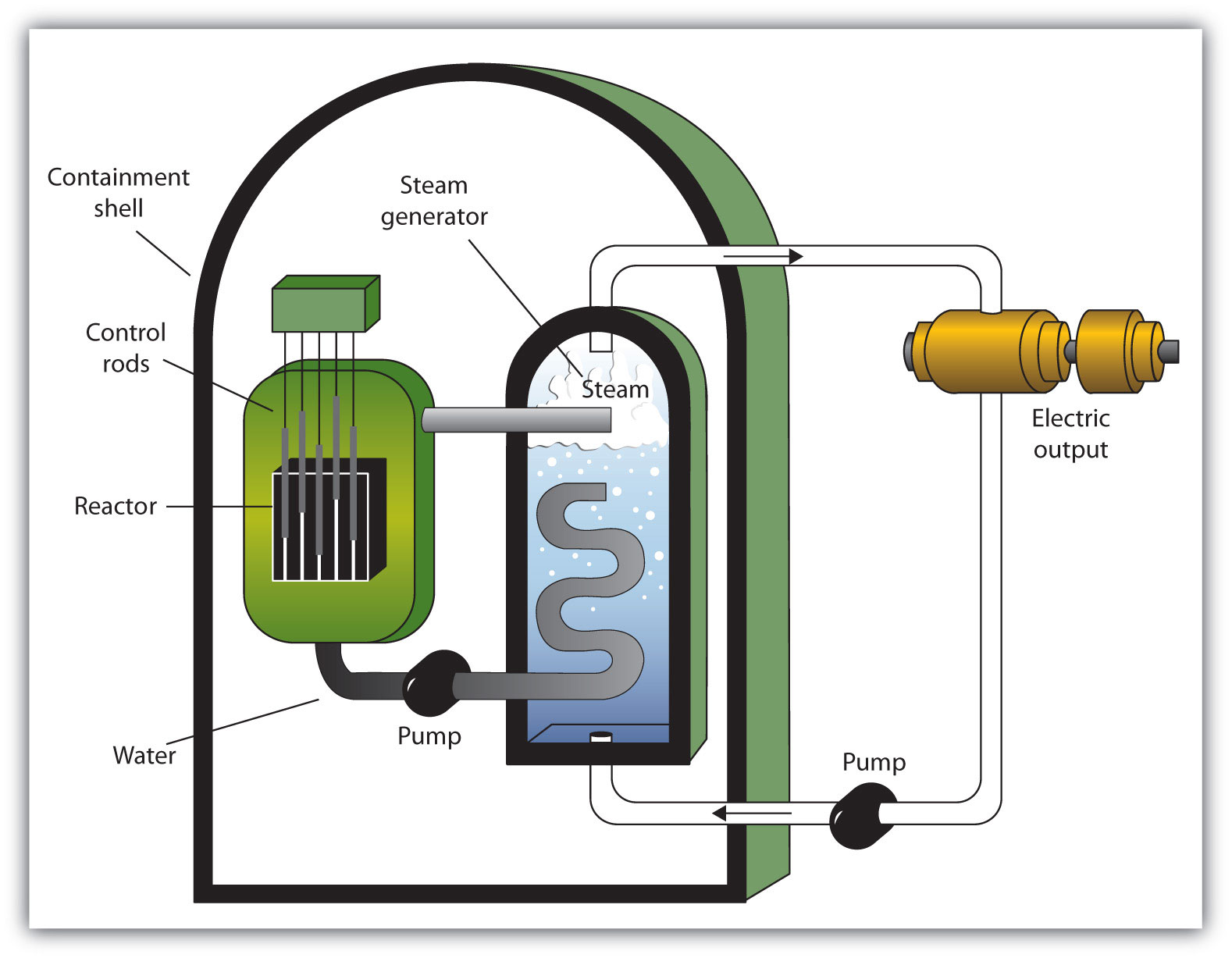Nuclear Reactions
Balancing Nuclear Reactions

In nuclear reactions, the individual number of protons and or neutrons can change, but the total number of protons and neutrons are conserved and remain constant. Consequently, nuclear changes may be tracked using the atomic and mass numbers on the atoms and particles involved in the change. Individual elemental isotopes or nuclides are distinguished by their atomic number and mass number. The atomic number, or number of protons, determines the identity of the element. The mass number is the combined total number along with the elemental symbol are used to identify a particular nuclide. The atomic number, often designated as Z, is subscripted to the lower left of the elemental symbol and the mass number superscripted to the upper left of the elemental symbol. For example, the isotope of thorium, element 90, with mass of 234 is written:
\(^{234}_{90}\text{Th}\).
To make balancing nuclear reactions easier, a beta particle is written as a lowercase e symbolizing that it is an electron with a zero placed in the upper left mass number position, indicating that an electron has negligible mass compared to either a proton or neutron. A minus –1 is placed to the lower left atomic number position, indicating that emission of the negatively charged beta particle from the nucleus. Similarly, a positron is written as a lowercase p, but with a +1 to the lower left of the p to indicate its charge.
Beta Particle: \(^0_{-1}e\)
Positron: \(^0_{+1}e\)
Thorium-234 undergoes beta decay by emitting a beta particle (an electron). In this process, a neutron is converted into a proton, and a negatively charged beta particle is emitted from the nucleus. As a result, the atomic number increases by one, while the mass number remains the same. The beta decay of a single thorium-234 atom produces an atom of element 91, with a mass number of 234—protactinium-234, written as
$^{234}_{91}\text{Pa}$
An equation depicting this decay process can be written similar to a standard chemical equation like this:
$^{234}_{90}\text{Th} \rightarrow ^{234}_{91}\text{Pa} + ^{0}_{-1}e$
When written in this format, both the atomic number designations and the mass number designations are balanced on both sides of the equation. This is true for the following examples of nuclear decay reactions that emit other particles or rays.
Fission and Fusion Reactions

A nuclear decay event is a single-atom nuclear reaction whose product is a single atom, but it is also possible for the nucleus of a single atom to absorb a nuclear particle or to break apart and form two different atoms. In addition, two nuclei may fuse with each other. All of these processes result in the formation of different elements. In each case, a reaction equation similar to those depicting nuclear decay reactions can be written and balanced by mass number and by atomic number.
The creation of carbon-14 is an example of a nucleus capturing a nuclear particle, in this case, a neutron. This particular reaction occurs in the upper atmosphere and is initiated by energetic cosmic rays, which produce free neutrons. In this reaction, a single nitrogen-14 atom reacts with a free neutron to produce an atom of carbon-14 with the emission of a proton, according to this reaction:
$^{14}_7\text{N} + ^1_0n \rightarrow ^{16}_6\text{C} + ^1_1p$
As in all nuclear reactions, the atomic numbers and mass numbers are balanced in this reaction.
Some larger unstable nuclei decay by splitting apart to form smaller nuclei, in a process known as nuclear fission, from the Latin fissio, meaning to split.
This reaction: $^{236}_{92}\text{U} \rightarrow ^{91}_{36}\text{Kr} + ^{142}_{56}\text{Ba} + 3^1_0n$ is an example of a uranium atom undergoing a fission event. Again, the atomic numbers and the mass numbers are balanced.

Some larger unstable nuclei decay by splitting apart to form to smaller nuclei, in a process known as nuclear fusion. In the initial reaction of the fusion process that power the sun, two hydrogen-1 atoms combine to produce an atom of hydrogen-2 and a neutron. The hydrogen-2, in turn, reacts with two helium-3 atoms fuse to produce helium-4, which is stable, and two hydrogen-1 atoms. This series of reaction can be written as nuclear equations like this:
$^1_1\text{H} + ^1_1\text{H} \rightarrow ^2_1\text{H} + ^1_0n$
$^2_1\text{H} + ^1_1\text{H} \rightarrow ^3_2\text{He}$
$2^3_2\text{He} \rightarrow ^4_2\text{He} + 2^1_1\text{H}$
Each of these individual equations is balanced.
The elements 95-118 along with three others, 43, 61, and 93 are man-made and not naturally occuring, meaning they are not found naturally occurring on earth. Many of these higher atomic number elements have been made in a particle accelerator by the collision of two smaller nuclei that combine to form a larger nucleus. An example of one of these reactions is the synthesis Rutherfordium 257 by the collision of californium-249 and carbon-12 according to this reaction:
$^{249}_{98}\text{Cf} + ^{12}_6\text{C} \rightarrow ^{257}_{104}\text{Rf} + 4^1_0n$

Nuclear Reactions and Energy

Nuclear fission and fusion reactions are capable of releasing enormous amounts of energy. The energy released from ordinary chemical reactions depends on the change in the electrostatic force, and is dependent on the interaction of the electrons and protons within and between atoms. However, the energy released from nuclear reactions depends on the strong nuclear force, which is the force that binds protons and neutrons together in the nucleus. The strong force is strong enough to overcome the electrostatic repulsion of the positively charged protons that occupying the incredibly small volume of the atomic nucleus. Consequently, the strong force is orders of magnitude stronger than the electrostatic force. So, any change in the strong force results in the release of a huge amount of energy. Both fission and fusion are nuclear reactions that release energy associated with the strong force. Fission reactions power nuclear power plants and both nuclear fission and fusion reactions are responsible for the energy released in atomic or nuclear weapons. Hydrogen fusion reactions releases more energy than fission reactions and it is these reactions are responsible for the energy released in a hydrogen bomb.
A nuclear reactor designed to produce electrical energy uses uranium-235 as a fuel. This uranium isotope is present in naturally occurring uranium deposits in amounts of slightly less than 1% and must be enriched to higher amounts if the uranium is to be used as nuclear fuel. Further U-235 enrichment is required to produce atomic weapons. When exposed to a slow neutron source, the \(^{235}_{92}\text{U}\) nucleus is able to capture a neutron to produce uranium-236 nuclide, which is readily fissionable. When the \(^{235}_{92}\text{U}\) nucleus breaks apart, it produces atoms of two different elements and as well as, neutrons. The neutrons produced in this reaction, in turn, many react with other uranium-235 nuclei and initiate the fission process over and over again, with increasing number of atoms reacting with each round. Self-perpetuating reactions like these are termed chain reactions. If the \(^{235}_{92}\text{U}\) chain reaction continues uncontrolled, it results in a nuclear explosion or an atomic bomb. However, if the reaction is controlled by absorbing some of the neutrons produced in each cycle of the chain reaction, the energy released in uranium fission reactions can be harnessed to produce electricity in a nuclear power plant.


Measuring Radiation and Radiation Exposure

Exposure to radiation can result in a number of negative health effects ranging from sunburn-like irritation to cancer. In contrast, controlled and carefully directed exposure to radiation is used as a therapy to treat some diseases, most notably, cancer. Consequently, it is important to be able to measure and track radiation exposure. A sheet of paper or clothing is protection enough to stop alpha particles, which are only capable of penetrating tissue to the depth of 0.05 mm. Beta particles, on the other head, are more penetrating and require heavier clothing and gloves to block them. They have the ability to penetrate tissue to the depth of 4 to 5 mm. Gamma rays are very penetrating and require extensive shielding as protection from exposure. They have the ability to penetrate tissue to the depth of 50 cm.
Radiation is measured in terms of the number of nuclear disintegration reactions a radioactive sample undergoes, in terms of radiation energy absorbed, and in terms its potential for biological damage.
The curie, whose symbol is Ci, and the Becquerel, whose symbol is Bq, are both units that describe the number of nuclear disintegrations that occur in 1 second. One curie or 1 Ci is defined relative to a 1 g sample of pure elemental radium, which undergoes \(3.7 \times 10^{10}\) disintegrations in 1 sec. The Bq is defined as 1 disintegration per 1 sec. Consequently, \(1 \text{Ci} = 3.7 \times 10^{10}\text{Bq}\).
The gray, symbol Gy is a unit that describes the amount of radiation energy absorbed by 1 kg of body tissue. The rad, which is also a unit that describes the amount of energy absorbed is equal to 0.01 Gy, meaning that \(100 \text{rad} = 1 \text{Gy}\).
The Sievert, symbol Sv, is a unit that measure the biological effect of the radiation exposure and is dependent on the type of radiation. Absorbed alpha particles are 20 times more damaging than beta particles, gamma rays, or x-rays, meaning that an exposure of 1 Sv of alpha radiation is equal to 20 Sv of exposure of beta radiation. The rem is another unit that describes the biological effect of radiation exposure and is equal to 0.01 Sv or in other words, \(1 \text{Sv} = 100 \text{rem}\).



- OpenStax, Nuclear fission of U-235 produces a range of fission products., lumenLearning (CC BY 4.0).
Andy Schmitz, A nuclear Chain Reaction, 2012books.lardbucket.org (CC BY-NC-SA 3.0).
Jim Doyle, Chain Reaction, emc2-explained
Andy Schmitz, A Nuclear Transmutation Reaction, 2012books.lardbucket.org (CC BY-NC-SA 3.0).
wlad074/stock.adobe.com/stock.adobe.com, Nuclear power plant against sky by the river at sunset , (Adobe Stock Education License).
Andy Schmitz, A Diagram of a Nuclear Power Plant for Generating Electricity, 2012books.lardbucket.org (CC BY-NC-SA 3.0).
CPEPphysics, Nuclear Energy Poster, Unknown
unknown, radiation measurement, brmlab.cz
OpenStax, NX Chem 21 06 Exposure, Wikimedia Commons (CC BY 4.0).
Unknown, Radiological Protection , Unknown
N/A, Health Effects of Ionizing Radiation, goflightmedicine.com
unknown, A Nuclear Transmutation Reaction, chem.libretexts.org (CC BY-NC-SA 3.0).